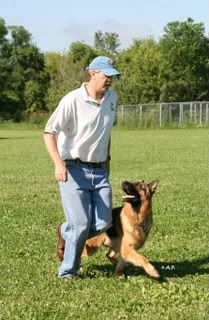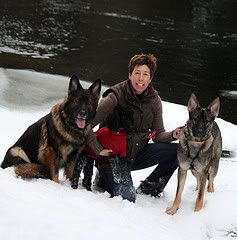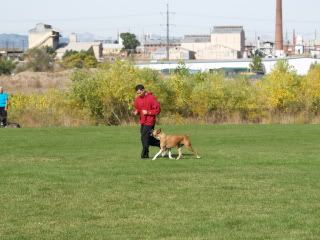At Cindy's suggestion, I'm a noting the way we introduced biking to our dog to condition him generally, and successfully prepare for the AD. For those not familiar with the AD test, it is an endurance test often done in conjuction with other Schutzhund related trial or conformation events. It is a 20km (approx. 12 miles) bike ride with your dog beside you (or slightly in front of you). Here is a link to a web site with more details on the rules for the AD. (I hope posting this link is OK! I don't know the folks at this club)
http://www.willamettevalleyschutzhundclub.com/ad.htm
The AD is one of the requirements for German Shepherd dogs to obtain a Breed Survey - at least through the United Schutzhund Clubs of America and I also think that's true for the GSDCA-WDA. I seem to recall there may be an exception for dogs over a certain age (6 maybe?) - maybe somebody knows that for sure..
Anyway, we prepared for the AD by utilizing the advice of both Cindy Jones-Petersen and Dave Blank who are both professional trainers. What they recommended worked! But Gary and I are beginners and I'm sure there are other ideas from more experienced people here.
1. If you are working towards an AD, find out what type of surface the event you plan to enter will be run on. Seek a similar surface for preparation.
2. Not only does the dog need to build up aerobic and muscular condition for biking long distance, but especially needs to gradually build up calouses on the pads. (We bike on trails that are a combination of asphalt and crushed limestone. Gary ran the AD on a country road that was paved, with gravel shoulders)
3. There are options for how to "attach" the dog to you and the bike. Some people use springer devices - some like them, some hate them. Some people tie the dogs leash to the handle bars - the last person I saw do it that way broke a few ribs during an actual AD. Gary prefers to hold the leash in his hand, which is what both Cindy and Dave also do. While there is a risk I suppose of a dog running off, we think there is less risk of injury to the biker and the dog by having this manual "quick release" option in place.

4. An odometer/speedometer type gizmo on the bike is helpful. Helmets are highly, highly recommended. A rearview mirror is also helpful at times.
5. Start off slowly. Gary started with 1/2 mile total distance - 1/4 mile out and back. Check the pads after each and every outing - even the short ones. Look for any cracks. Look for any splinters or things like that. If Gary ever noticed a small crack or had to pull a splinter, he treated it with betadine and did not resume biking until the pads were fully healed. Not pushing it too hard at first is key to keeping the pads in good shape and building up the calouses slowly. Gary biked every other day to have a recovery day in between. He gradually increased the distance.
6. Dave, whose personal dogs are usually working lines and tough ones at that, prefers to have the dog fuss next to him on a loose line during the AD. Cindy who mainly works with show line dogs for Schutzhund titles and ring conditioning prefers the dog to go in front of her at a gait and with leash tension similar to gaiting in a show ring. Either way seemed fine as far as the judges were concerned in the events I've seen. I believe the pace in the official requirements is 7 - 9 miles per hour. (not sure how that translates to km per hour). That was our target training range and target pace during the actual AD. Ideally the dogs should gait - which is a specific type of movement that is very efficient for the German Shepherd. It's not really a "trot" and it's definitely not a "lope." While I haven't seen trotting get a negative in a judge critique, the judges don't like to see dogs "running" or "loping." (and dogs who do this are unlikely to make the full 12 miles, at least from the events I have watched which are admittedly limited)
7. As training distances increase, check pads during breaks (or at least at the turnaround point) and depending on weather conditions, etc. give water as appropriate. I've always been advised NOT to allow gulping great amounts of water when the dog is hot - sipping smaller amounts is better I'm told. I have also been advised to NEVER give hot dogs ice cold water - only air temperature water.
8. Gary spent 3 months conditioning for the 12 mile AD. He started in March and did the AD at the end of May. By early May, Gary and Fergie were able to regularly go 6 miles. We were advised that this is a good training distance, with occassional full 12 mile runs. I think Gary did the full 12 miles 3 times before the actual AD - no more than once per week.
9. Problems on the trail - of course that will vary by venue. The problems Gary regularly encountered were of course other bikers, hikers and joggers. At first, Gary would just take a pause as others went by to let Fergie get used to those distractions. Stopping totally isn't necessarily the best option. Gary would often just get off the bike and shorten up the leash and keep walking. Once Fergie got used to this stuff and Gary was pretty sure he wouldn't get pulled over

they just kept on going. The occassional motorized vehicles (illegal on these trails, but present on occassion) were another distraction high on the watch list. And then there is the wild life which tends to catch you by surprise. At first, that's when Gary was glad to be wearing a helmet.

Of course these distractions were all good training and learning opportunities for the team. And of course all of this should be a plus as Gary and Fergie are now getting ready for their BH.
Many people that I have run across on our Schutzhund adventure seem to treat the AD as a nuisance. I suppose I can see that on the part of more experienced folks. For Gary as a beginner, he LOVED the opportunity to train and bond with his dog in this way. It was also Gary's first opportunity to go in front of a judge in a "trial" situation. He was so proud of this accomplishment with his first Schutzhund dog. So I DO this the AD has a certain value to beginners in the sport! And our dog never looked better in terms of condition.
And now to Robinn's question about power. Some of you may know Tom Trainor. He happened to be at the trial where Gary and Fergie did the AD in the morning. Then at lunch time, Dave was warming up to do helper work for the trial protection phases. He had Gary bring Fergie out for a few bites. Tom said "I like that dog - he has a lot of power." (Tom had no idea Ferguson had run the AD in the morning) There is no question in my mind about the value of this kind of conditioning for so many positive reasons.
Like I said, we're beginners. I'm sure there are many other great suggestions and tips and ideas among this experienced community.
Beth
 Previous Topic
Previous Topic Index
Index Next Topic
Next Topic













 they just kept on going. The occassional motorized vehicles (illegal on these trails, but present on occassion) were another distraction high on the watch list. And then there is the wild life which tends to catch you by surprise. At first, that's when Gary was glad to be wearing a helmet.
they just kept on going. The occassional motorized vehicles (illegal on these trails, but present on occassion) were another distraction high on the watch list. And then there is the wild life which tends to catch you by surprise. At first, that's when Gary was glad to be wearing a helmet. 
 Top
Top

 Is that correct Beth?
Is that correct Beth?


.jpg)

